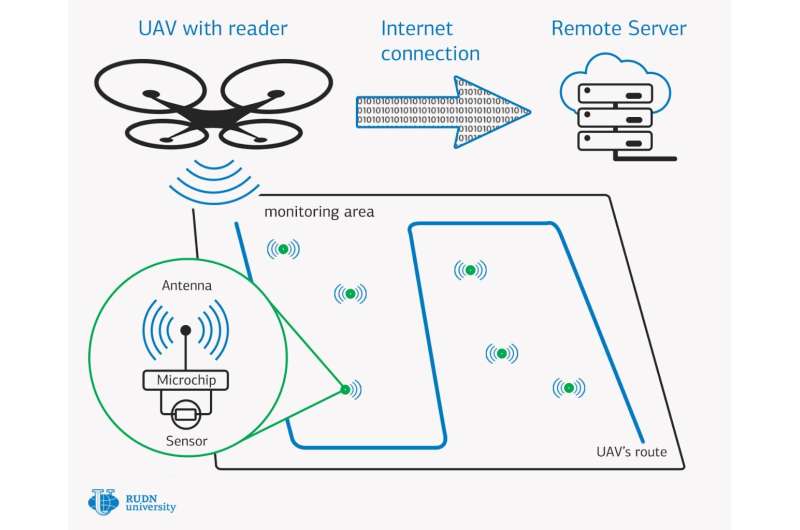Mathematicians propose new design for wireless nanosensory networks

RUDN University mathematicians have developed a new method of collecting data from passive wireless nanosensors. These devices measure the parameters of objects and convert them into a signal. They use microscopic nanoelements and do not have an integral battery pack. Mathematicians have modeled an experiment with gateways, which are made on the basis of unmanned aircraft. It showed that integration with such gateways could provide convenient wireless power transfer to the transmitter and unhampered information collection through flexible and dynamic drone routes. The article is published in the journal Computer Communications.
Passive nanosensors can be useful in a variety of situations: from monitoring the state of the body to studying the soil, air or objects such as pipelines, dams, or dikes. But the capabilities of these sensors are limited, as they do not have batteries and processors. To supply the sensors with sufficient energy, we need mechanisms that would perform this task. In addition, devices to collect data from sensors are needed. RUDN University mathematicians, Rustam Pirmagomedov and Mikhail Blinnikov, proposed using nanogateways based on unmanned aircraft to transmit the collected information to them and to provide continuous online monitoring of observed objects.
The nanosensors consist of several parts: nano-nodes (sensors), nano routers and nano/microgateways. Nano-nodes collect data using electromagnetic waves that radiate nano routers and also transform these waves into energy for operation.
Nano routers read information from sensors and microgateways are responsible to get the data. A wireless network is provided by graphene antennas, which are capable of transmitting and receiving radiation in the THz band.
RUDN University mathematicians conducted a simulation using a simulator on a conditional field of 500*500 meters. The aircraft used for the installation of sensors at predetermined points or in a random order. The first option takes longer but requires fewer sensors to cover the field. The second option is faster, but it requires more sensors, and the data collection scheme can become heterogeneous.
The gateways were conditionally integrated into devices that flew over the field, emitted electromagnetic waves and collected information from sensors. Each sensor measured the temperature, humidity, pH of the environment on its square meter. RUDN University mathematicians considered carrier frequencies from 0.1 to 0.15 THz, calculated the time of reception of energy by sensors and the time of data transmission at different speeds of drones and different radii of electromagnetic radiation.
With the smallest radiation radius of 0.6 m and the lowest speed of the drone 1 m/sec, the time of the drone to service 1 hectare was approximately 2.5 seconds. With an increase in speed or with each extension in the radius of 0.2 m/s, the operation time of the drone decreased. At high speeds, the sensors did not have time to store energy, and an extension the radius reduced antenna gain and reduced the amount of energy transmitted to the sensors. So, the operation speed of the drones depended on the speed of their flight and the radius of electromagnetic radiation.
Thus, the use of nano-gateways based on unmanned aircraft was possible. This gives advantages over ground gateways, which cannot move or choose convenient routes depending on the obstacles in the way.
Since the integration of passive wireless nanosensor networks and drones has shown positive results, RUDN University mathematicians will continue to study its capabilities. In the near future researchers plan a simulation of joint work of sensors and gateways taking into account weather conditions and possible obstacles for the drone. Nanotechnology further expands the scope of such networks where it is inconvenient or dangerous for a person to work—in large areas, in disaster zones or hard-to-reach places. Therefore, the investigations of specialists in this field are important for the development of the spheres where environmental control is important.
More information: Rustam Pirmagomedov et al. UAV-based gateways for wireless nanosensor networks deployed over large areas, Computer Communications (2019). DOI: 10.1016/j.comcom.2019.07.026
Provided by RUDN University





















